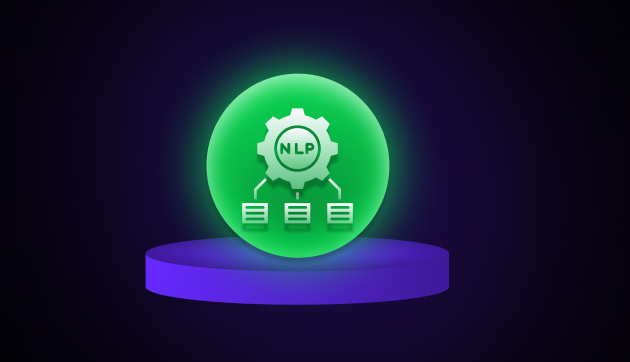
Basics of NLP: A Beginner’s Guide to Natural Language Processing
Sep 05, 2024 4 Min Read 12577 Views
(Last Updated)
As an artificial intelligence (AI) enthusiast, I am always intrigued by the power of natural language processing (NLP). NLP is a subfield of AI that deals with the interaction between humans and computers using natural language and it has become one of the most in-demand careers in the tech industry.

According to Fortune Business Insights, the natural language processing (NLP) market is set to grow from $26.42 billion in 2022 to an astonishing $161.81 billion by 2029, at a cumulative CAGR of 18.1%! Now those are numbers that scream CAREER GROWTH, and quite a substantial one at that.
So to keep our dear learners up-to-date, in this article, I will guide you through the basics of NLP, its applications, techniques, tools, and software, common challenges, and the future of NLP. We will also discuss how you can get started with NLP in a few simple steps.
Table of contents
- Introduction to Natural Language Processing (NLP)
- What is Natural Language Processing?
- NLP in Artificial Intelligence (AI)
- How it works...
- Getting Started with Natural Language Processing in 7 Simple Steps
- 1)Understand the Fundamentals of Natural Language Processing
- 2)Choose a Programming Language and Framework
- 3)Collect and Preprocess Data
- 4)Choose the Right NLP Task
- 5)Train and Evaluate Models
- 6)Deploy Your Model:
- 7)Stay Up-to-Date with the Latest NLP Research
- Common Challenges
- NLP in Business: Real-World Examples
- Conclusion
Introduction to Natural Language Processing (NLP)
What is Natural Language Processing?
To put it quite simply, Natural Language Processing (NLP) is a branch of computer science, artificial intelligence, and linguistics that deals with the interaction between humans and computers using natural language.

It is a technology that enables computers to understand, interpret, and generate human language. NLP involves the use of algorithms and statistical models to extract meaning from human language.
NLP in Artificial Intelligence (AI)
NLP is an essential component of AI, as it enables computers to interact with humans using natural language. AI systems that use Natural Language Processing can understand and interpret human language, which makes them more effective at tasks such as customer service, support, and communication.

As a result, knowing and understanding NLP is of the utmost importance in today’s tech world and will prove to be very beneficial for your career.
How it works…
NLP works by breaking down human language into smaller components such as sentences, phrases, and words. It then applies various techniques such as machine learning, deep learning, and natural language understanding to analyze and derive meaning from the language.
NLP algorithms use statistical models to identify patterns in the language, which are then used to make predictions or generate responses.
Before moving forward, make sure you understand the basics of Artificial Intelligence & Machine Learning, including algorithms, data analysis, and model training. If you want to learn more, join GUVI’s AI & Machine Learning Career Program with job placement assistance. You’ll discover important tools like TensorFlow, PyTorch, scikit-learn, and others. Plus, you’ll work on real projects to gain practical experience and improve your skills in this fast-growing field.
Also, if you want to learn Natural Language Processing with Python through a Self-paced course, try GUVI’s Natural Language Processing with Python, a Self-Paced course.
Getting Started with Natural Language Processing in 7 Simple Steps
If you are interested in getting started with NLP, here are some simple steps to get you started:
1)Understand the Fundamentals of Natural Language Processing
To begin with, you need to understand the fundamental concepts and techniques involved in natural language processing. Here are some techniques that you must study:
- Tokenization: The process of breaking up text into smaller units, such as words or phrases.
- Part-of-Speech (POS) Tagging: The process of labeling words in a sentence as nouns, verbs, adjectives, etc.
- Named Entity Recognition (NER): The process of identifying named entities in a text, such as people, places, and organizations.
- Stemming: The process of reducing words to their base form, such as “running” to “run”.
- Lemmatization: The process of reducing words to their base form, but taking into account the context of the sentence.
- Sentiment Analysis: The process of determining the emotional tone of a text, such as positive or negative.
2)Choose a Programming Language and Framework
The next step is to choose a programming language and framework for Natural Language Processing. There are many programming languages that can be used for Natural Language Processing, including Python, Java, and C++. Python is a popular choice because it has many libraries and tools specifically designed for NLP.
Here are some popular Python libraries for Natural Language Processing:
- NLTK: The Natural Language Toolkit is a library for Natural Language Processing that provides tools for tokenization, POS tagging, NER, stemming, and more.
- spaCy: A library for Natural Language Processing that is designed for performance and scalability. It provides tools for tokenization, POS tagging, NER, and more.
- Gensim: A library for topic modeling, document indexing, and similarity retrieval with NLP.
- TextBlob: A library for Natural Language Processing that provides tools for sentiment analysis, part-of-speech tagging, and more.
- TensorFlow: A popular machine learning library that can be used for NLP tasks such as text classification and language modeling.
3)Collect and Preprocess Data
The quality of data is crucial in NLP, and it is essential to have a large and diverse dataset to train models accurately. Collecting and preprocessing data involves cleaning and formatting raw text data to remove unwanted characters, stop words, and other noise.
You can use tools like Beautiful Soup, Scrapy, or Selenium to extract data from websites or social media platforms.

4)Choose the Right NLP Task
NLP involves various tasks such as sentiment analysis, text classification, machine translation, question answering, and text summarization. To get started with Natural Language Processing, it is recommended to start with simple tasks such as sentiment analysis or text classification using pre-built models available in Natural Language Processing libraries.
5)Train and Evaluate Models
After choosing the correct Natural Language Processing task and selecting the right library or framework, the next step is to train and evaluate the model. Training a model involves feeding it with preprocessed data and adjusting the model parameters to optimize performance.
The evaluation of the model is done using metrics such as accuracy, precision, recall, and F1-score.
6)Deploy Your Model:
Deploy your NLP model in a real-world setting, such as a chatbot or customer service application. This will give you first-hand experience in not just deploying your very own model but also maintaining and improvising it with time.
7)Stay Up-to-Date with the Latest NLP Research
Natural Language Processing is an ever-evolving field, and staying up-to-date with the latest research and trends is crucial to becoming proficient in NLP. Follow blogs, newsletters, and social media accounts of prominent researchers and organizations to keep up with the latest developments in the field.
Common Challenges
NLP is a complex field, and there are several challenges that come with it. Some of the most common challenges include:

- Ambiguity: Human language is often ambiguous, which makes it challenging for computers to understand and interpret.
- Complexity: Human language is complex, and there are many nuances, idioms, and cultural references that computers may not understand.
- Data Quality: Natural Language Processing algorithms rely on high-quality data to be effective. Poor quality data can result in inaccurate or biased results.
- Multilingualism: Natural Language Processing algorithms must be able to handle multiple languages, which can be challenging, especially for languages that are less common.
NLP in Business: Real-World Examples
Here are some real-world examples of how businesses are using NLP today:
1)Customer Service
Many businesses are using NLP-powered chatbots to provide 24/7 support to customers. For example, airlines are using chatbots to handle common customer queries such as flight information and baggage allowance.

2)Sentiment Analysis
Businesses are using Natural Language Processing to analyze customer feedback on social media and review sites. This enables them to understand the sentiments of their customers and make improvements to their products and services.
3)Email Management
Natural Language Processing can be used to automate email management tasks such as sorting and prioritizing emails. This can save businesses time and improve their response times to customer inquiries.
4)Fraud Detection
It can be used to detect fraudulent activity in financial transactions. For example, banks are using Natural Language Processing to analyze customer transactions and detect suspicious activity.
Conclusion
Natural Language Processing is a powerful technology that is becoming increasingly important in today’s world. NLP enables computers to understand and interpret human language, which has many applications in business and beyond.
By following the steps outlined in this article, you can get started with NLP and unlock its power for your career or business! Would you like to master NLP and all things data?
Begin your Artificial Intelligence & Machine Learning journey with GUVI’s Artificial Intelligence & Machine Learning Career Program. Learn essential technologies like matplotlib, pandas, SQL, NLP, and deep learning while working on real-world projects.
Alternatively, if you want to explore Natural Language Processing with Python through a Self-paced course, try GUVI’s Natural Language Processing with Python, a Self-Paced course.
























Did you enjoy this article?